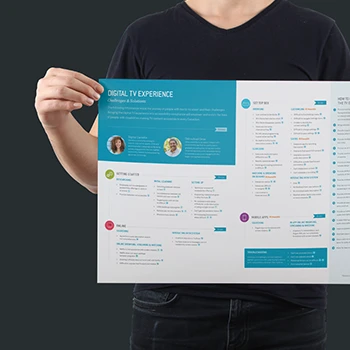How does Experience Thinking apply to telecom UX design?
Our Experience Thinking framework addresses four connected areas: how people experience your brand, content, products, and services. In telecom, this means ensuring your brand communicates reliability and innovation, your content simplifies complex technical information, your products work seamlessly across devices and networks, and your services support customers through connectivity issues and plan changes. Each area strengthens the others to create experiences that reduce churn and increase customer satisfaction.
Tip: Map the complete customer lifecycle from plan shopping through device setup, usage, and support to identify where each Experience Thinking area can reduce friction and build loyalty.
What makes telecom UX different from other industries?
Telecom involves complex technical infrastructure that customers interact with indirectly through devices and services. Users expect always-on connectivity with minimal friction, but often need support navigating complex plans, billing, and device configurations. The industry faces intense competition, rapid technology changes, and highly regulated environments while serving diverse customer segments with varying technical expertise.
Tip: Design experiences that hide technical complexity while providing transparency about service quality, coverage, and billing to build trust with customers who rely on your infrastructure daily.
How do you understand the needs of different telecom customer segments?
We research distinct segments including individual consumers, families, small businesses, and enterprise customers through behavioral interviews and usage analysis. Each segment has different priorities - consumers focus on value and simplicity, families need shared plans and parental controls, businesses require reliability and scalability, while enterprises need integration capabilities and dedicated support.
Tip: Create separate user personas for different usage patterns (heavy data users, voice-focused customers, international travelers) rather than just demographic segments since usage drives different needs.
What's your approach to balancing technical complexity with user simplicity?
We design layered experiences that provide simple defaults for most users while making advanced options accessible when needed. This includes intelligent automation that handles technical details behind the scenes, progressive disclosure that reveals complexity only when relevant, and clear explanations that help users understand what technical choices mean for their experience.
Tip: Use customer language rather than technical jargon in interface design, but provide tooltips or help sections that explain technical terms when customers want deeper understanding.
How do you help us define UX strategy for telecom products and services?
Using our Experience Thinking approach, we examine how customers experience your brand promise, navigate service information, interact with products across multiple touchpoints, and receive ongoing support. We identify where current experiences create satisfaction or frustration, then develop strategies that align with both business goals and customer needs across the complete telecom relationship.
Tip: Focus on moments that matter most to customers - network outages, bill surprises, device problems - since these high-stress interactions disproportionately impact customer loyalty.
What role does trust play in telecom UX design?
Trust is essential since customers depend on telecom services for critical personal and business communications. We design experiences that demonstrate reliability through consistent performance, show transparency through clear billing and service information, and build confidence through proactive communication about service issues and improvements.
Tip: Include real-time service status information and outage updates in customer-facing interfaces since transparency during problems often builds more trust than trying to hide issues.
How do you approach UX strategy for both consumer and business telecom markets?
Consumer and business telecom require different experience approaches - consumers prioritize simplicity and value while businesses need detailed control and integration capabilities. We design flexible frameworks that accommodate both markets while recognizing their distinct needs for support, billing complexity, and service reliability requirements.
Tip: Create role-based access within business accounts so different employees can manage the features relevant to their responsibilities without overwhelming them with enterprise-level complexity.
What research methods work best for understanding telecom customer behavior?
We use behavioral interviews to understand how people use telecom services throughout their day, diary studies to track usage patterns and pain points over time, and contextual inquiry to observe how customers interact with devices and services in real-world settings. Journey mapping reveals critical moments where service quality impacts customer satisfaction.
Tip: Conduct research during both normal usage periods and service disruptions to understand how customer needs and emotions change when telecom services aren't working as expected.
How do you research customer service and support experiences?
We observe actual customer service interactions across multiple channels, analyze support ticket patterns and resolution flows, and interview both customers and support representatives about their experiences. Research includes studying both successful problem resolution and frustrating support experiences to understand what separates effective from ineffective service delivery.
Tip: Shadow customer service representatives during different types of calls (technical support, billing questions, plan changes) to understand how current tools help or hinder effective problem resolution.
What's your approach to testing mobile and device interfaces for telecom services?
We test telecom interfaces across multiple devices, network conditions, and usage contexts since performance varies significantly across different environments. Testing includes both controlled usability studies and field testing during actual usage scenarios. We examine how interface design performs under different signal strengths and network loads.
Tip: Test telecom apps and interfaces under degraded network conditions since poor connectivity often reveals usability issues that don't surface during ideal testing environments.
How do you research cross-channel customer experiences in telecom?
Telecom customers interact across multiple channels - mobile apps, websites, physical stores, phone support, and device interfaces. We use customer journey mapping and channel transition studies to understand how customers move between touchpoints and where information or context gets lost during handoffs between channels.
Tip: Track customer interactions across channels for specific issues to identify where channel switching adds friction rather than providing helpful alternatives.
What role does accessibility research play in telecom UX?
Accessibility research ensures telecom services work for users with diverse abilities and needs. We conduct studies with customers who have visual, hearing, motor, or cognitive differences to understand how they access telecom services. Our work with Rogers on accessible TV experiences demonstrates the importance of inclusive design in telecom.
Tip: Include assistive technology users in your research since they often discover innovative ways to use telecom services that can improve the experience for all customers.
How do you validate billing and account management experiences?
Billing research examines both the practical usability of account management interfaces and the emotional impact of billing surprises or confusion. We study how customers interpret usage information, navigate plan options, and respond to billing changes. Research reveals where complex telecom pricing creates customer confusion or distrust.
Tip: Test billing interfaces with customers who have different levels of technical understanding since plan complexity affects people differently based on their telecom knowledge.
What's your approach to researching network performance perception?
Network perception research examines how customers experience and interpret service quality across different locations, times, and usage scenarios. We study the relationship between actual network performance and customer satisfaction to understand when technical metrics align with user experience and when they diverge.
Tip: Research network perception during different activities (video calls, streaming, gaming) since users have different expectations and tolerance levels for performance based on their current task.
How do you design account management experiences that simplify complex telecom plans?
Through our Experience Thinking content quadrant, we design account interfaces that present plan information using customer language and visual hierarchies that highlight the most relevant details. We use progressive disclosure to manage complexity, create comparison tools that help customers understand their options, and design billing presentations that clearly explain charges and usage.
Tip: Design plan comparison tools that focus on real usage scenarios rather than technical specifications, helping customers understand how different plans would affect their actual experience and costs.
What's your process for designing mobile network and coverage tools?
Network tool design helps customers understand service availability and quality in locations that matter to them. We create interactive coverage maps, design speed testing tools that provide actionable insights, and build reporting mechanisms that help customers communicate service issues effectively. The goal is transparency about network performance and improvement efforts.
Tip: Include historical performance data in coverage tools so customers can see network improvement trends rather than just current status, building confidence in ongoing service quality.
How do you approach mobile-first design for telecom applications?
Mobile telecom design recognizes that customers primarily access services through mobile devices, often while multitasking or in challenging environments. We design touch-friendly interfaces optimized for quick interactions, create offline capabilities for essential functions, and ensure critical information remains accessible even under poor network conditions.
Tip: Design telecom apps to work effectively with one hand since customers often use telecom services while holding other objects or during transportation.
What's your approach to designing customer support and troubleshooting experiences?
Support experience design combines self-service capabilities with human assistance options, creating escalation paths that preserve customer context throughout the resolution process. We design diagnostic tools that help customers solve common problems independently while ensuring complex issues can be transferred to appropriate specialists efficiently.
Tip: Create troubleshooting flows that automatically gather diagnostic information before connecting customers to support, enabling more effective and faster problem resolution.
How do you design accessible telecom experiences for users with disabilities?
Accessible telecom design goes beyond compliance to ensure everyone can access communication services independently. This includes screen reader optimization, alternative input methods, captioning capabilities, and support for assistive technologies. Our Rogers accessibility work shows how inclusive design benefits all customers while serving those with specific needs.
Tip: Partner with accessibility organizations during design development rather than retrofitting accessibility features, ensuring inclusive design from the beginning of your development process.
What's your approach to designing for different device types and screen sizes?
Telecom design must work across smartphones, tablets, computers, and smart home devices since customers access services from multiple devices throughout their day. We create responsive design systems that adapt functionality and information hierarchy appropriately for each device type while maintaining consistent brand and interaction patterns.
Tip: Design device-specific features that take advantage of each platform's unique capabilities rather than creating identical experiences across all devices.
How do you design for the emotional aspects of telecom service interactions?
Telecom interactions often involve frustration when services aren't working or confusion about technical issues. We design experiences that acknowledge customer emotions, provide empathetic communication during problems, and create positive moments that reinforce the value of reliable connectivity. The experience validates concerns while providing practical problem-solving support.
Tip: Design service interruption communications that focus on resolution timelines and workaround options rather than technical explanations, addressing customer needs during stressful situations.
How do you support development during telecom platform implementation?
We provide detailed specifications that include responsive design patterns, API integration requirements, and performance optimization guidelines specific to telecom applications. Our support includes design reviews throughout development, helping resolve complex technical questions, and ensuring final products handle telecom-specific workflows like billing, usage tracking, and network integration.
Tip: Establish performance benchmarks early in development since telecom applications must work reliably across varying network conditions and device capabilities.
What's your approach to measuring UX success in telecom applications?
Success metrics combine traditional usability measures with telecom-specific indicators like customer support call reduction, self-service completion rates, and customer satisfaction during service issues. We establish baseline measurements and track improvements in both user satisfaction and business outcomes like churn reduction and plan upgrade rates.
Tip: Include customer effort scores in your measurement framework since telecom customers value experiences that require minimal effort to accomplish their goals.
How do you handle UX iteration for platforms with multiple network integrations?
Network integration complexities require careful change management since design updates must work across different network technologies and service capabilities. We use testing frameworks that validate designs against multiple network scenarios and document design decisions that affect performance and feature availability for technical implementation teams.
Tip: Create fallback design patterns for features that depend on network capabilities so user experience degrades gracefully when advanced network features aren't available.
What's your approach to launching telecom products with diverse customer bases?
Launch strategies consider the different technology adoption patterns within telecom customer bases - early adopters versus traditional users, urban versus rural customers, and consumer versus business segments. We recommend phased rollouts that start with segments most likely to provide constructive feedback while monitoring network impact and support volume.
Tip: Launch new telecom features in geographically limited areas first to test network performance impact before rolling out to markets with different infrastructure characteristics.
How do you support ongoing UX optimization after telecom platform launch?
Using our Experience Thinking service quadrant principles, we establish monitoring systems that track customer behavior across all service touchpoints - mobile apps, websites, customer service, and device interactions. This includes regular feedback collection, performance monitoring under different network conditions, and analysis of support patterns to identify emerging user experience issues.
Tip: Set up automated monitoring for UX metrics during network maintenance windows since customer experience often changes when network capacity or features are temporarily reduced.
What's your approach to training telecom customer service staff on UX insights?
Training programs help customer service representatives understand how customers experience digital tools and how to use UX insights to provide better support. We focus on practical applications like identifying when digital tool problems require escalation versus when customer education can resolve issues effectively.
Tip: Include customer service representatives in UX research sessions so they can observe firsthand how customers struggle with current tools and contribute insights from their daily support interactions.
How do you help telecom organizations build internal UX capabilities?
We transfer knowledge through collaborative working relationships that build internal capabilities over time. This includes establishing UX processes for telecom applications, creating design systems that work across network technologies, and mentoring internal teams on user research methods relevant to telecom customer behavior and technical constraints.
Tip: Start with establishing customer feedback loops that capture both technical performance data and user experience metrics before building advanced UX research capabilities.
How do you design mobile interfaces that work across different network conditions?
Mobile telecom design must perform well across varying signal strengths and network technologies. We create adaptive interfaces that prioritize essential functions under poor network conditions, design offline capabilities for critical features, and use progressive loading to maintain responsiveness when bandwidth is limited. The goal is consistent usability regardless of network quality.
Tip: Include network condition indicators in mobile interfaces so customers understand when slow performance is due to network limitations rather than app problems.
What's your approach to designing data usage and plan management tools?
Data management design helps customers understand and control their usage through clear visualizations, proactive alerts, and easy plan adjustment options. We create usage tracking that shows consumption patterns over time, design prediction tools that help customers choose appropriate plans, and build controls that help manage data consumption effectively.
Tip: Design data usage tools that show consumption by app or activity type rather than just total usage, helping customers understand what drives their data needs.
How do you design device setup and configuration experiences?
Device setup design guides customers through initial configuration while minimizing technical complexity. We create step-by-step flows that handle network settings automatically when possible, design troubleshooting tools for common setup problems, and ensure customers can access help when automated setup fails. The experience builds confidence in both device and service functionality.
Tip: Include visual confirmation steps in device setup flows so customers can verify that connectivity and key features are working correctly before completing the setup process.
What's your approach to designing mobile payment and billing interfaces?
Mobile billing design presents complex telecom charges in digestible formats while enabling easy payment and plan management. We design bill presentations that clearly show usage charges, create payment flows optimized for mobile interaction, and build account management tools that work well on small screens while providing access to detailed information.
Tip: Design mobile billing interfaces with prominent usage alerts and spending controls since customers often check their account status while mobile and need quick access to usage information.
How do you design location-based services and network optimization features?
Location-aware design enhances telecom services by providing relevant information based on customer location and network conditions. We create tools that show nearby service centers or WiFi options, design features that optimize connectivity based on location patterns, and build privacy controls that give customers control over location data usage.
Tip: Include location-based service quality information in telecom apps so customers can understand why performance might vary in different areas and plan accordingly.
What's your approach to designing multi-device account management?
Multi-device design recognizes that telecom customers often manage multiple connected devices and services from a single account. We create unified dashboards that show all devices and services, design device-specific controls that make sense for each device type, and ensure account changes sync appropriately across all connected devices and interfaces.
Tip: Design device management interfaces that group related devices and services logically rather than listing them chronologically, making it easier to manage complex account configurations.
How do you design international roaming and travel features?
International service design helps customers maintain connectivity while traveling without unexpected charges or service interruptions. We create travel planning tools that explain international options, design automatic roaming controls that prevent bill shock, and build communication features that help customers stay connected affordably while abroad.
Tip: Include destination-specific information in travel planning tools, showing not just pricing but also coverage quality and local alternatives for staying connected.
How do you design network performance monitoring and reporting tools?
Performance monitoring design helps customers understand service quality in their specific locations and usage patterns. We create speed testing tools that provide actionable insights, design coverage maps that show real performance data, and build reporting mechanisms that help customers communicate service issues effectively to support teams.
Tip: Include historical performance data in monitoring tools so customers can track improvement trends and understand whether current performance issues are temporary or persistent.
What's your approach to designing service outage and maintenance communication?
Outage communication design provides timely, accurate information that helps customers understand service impacts and plan accordingly. We create status dashboards that show current issues and resolution progress, design notification systems that provide relevant updates without overwhelming customers, and build channels for customers to report new issues effectively.
Tip: Design outage communications that include estimated resolution times and alternative service options rather than just acknowledging that problems exist.
How do you design network upgrade and enhancement communication tools?
Network improvement communication helps customers understand how infrastructure changes will affect their service experience. We design educational content that explains new capabilities in customer terms, create tools that help customers take advantage of network improvements, and build feedback mechanisms that capture customer experience with upgraded services.
Tip: Include before-and-after performance comparisons in network upgrade communications so customers can understand the tangible benefits of infrastructure investments.
What's your approach to designing WiFi and hotspot management interfaces?
WiFi management design helps customers connect to and manage multiple network options seamlessly. We create automatic connection tools that prioritize networks appropriately, design hotspot sharing features that balance convenience with security, and build network management interfaces that work well across different device types and technical skill levels.
Tip: Design WiFi interfaces that remember and prioritize networks based on customer behavior patterns rather than just connection order or signal strength.
How do you design 5G and advanced network feature interfaces?
Advanced network design helps customers understand and utilize new capabilities without requiring technical expertise. We create feature discovery tools that explain benefits in practical terms, design optimization settings that improve performance for specific use cases, and build feedback systems that help customers troubleshoot advanced feature issues.
Tip: Design 5G feature interfaces that show real-world performance benefits for specific activities rather than technical specifications that don't relate to customer experience.
What's your approach to designing enterprise network management tools?
Enterprise network design provides business customers with detailed control and monitoring capabilities while maintaining usability for non-technical administrators. We create role-based dashboards that surface relevant information for different job functions, design reporting tools that support business decision-making, and build management interfaces that scale to complex network configurations.
Tip: Include business impact metrics in enterprise network tools, showing how network performance affects productivity and business operations rather than just technical performance data.
How do you design security and privacy controls for network services?
Security design balances protection with usability by providing clear controls that customers can understand and manage effectively. We create privacy dashboards that show data usage and sharing, design security tools that protect without creating excessive friction, and build educational resources that help customers make informed decisions about their privacy and security settings.
Tip: Design security interfaces that explain the practical implications of different settings rather than using technical language that doesn't help customers understand their choices.
How do you integrate AI tools into telecom experiences while maintaining customer trust?
AI integration in telecom requires transparency about automated systems while ensuring human oversight remains available for complex issues. We design experiences that clearly communicate when AI is providing network optimization, usage recommendations, or support assistance, maintain easy access to human customer service, and create systems where AI enhances rather than replaces human expertise in technical support.
Tip: Always provide clear explanations of how AI network optimization decisions are made and allow customers to override automated settings that don't match their preferences or usage patterns.
What's your approach to designing AI-powered network optimization and management?
AI network optimization design presents automated improvements in understandable terms while giving customers control over optimization priorities. We create interfaces that explain how AI improves network performance, design preference settings that guide optimization decisions, and build monitoring tools that show the impact of AI-driven network improvements on customer experience.
Tip: Include performance comparison data in AI optimization interfaces so customers can see measurable improvements from automated network management rather than just trusting that optimization is working.
How do you design AI-enhanced customer support and troubleshooting systems?
AI support design combines automated problem-solving with human expertise to resolve customer issues efficiently. We create chatbots that handle routine questions effectively, design escalation flows that preserve customer context when transferring to human agents, and build diagnostic tools that use AI to identify problems while maintaining clear explanation of troubleshooting steps.
Tip: Design AI support systems that learn from successful human agent interactions rather than relying only on scripted responses, improving problem resolution over time.
What's your approach to using AI for personalized plan and service recommendations?
AI recommendation design helps customers find optimal plans and services based on their usage patterns and preferences. We create systems that analyze customer behavior to suggest improvements, design comparison tools that explain why specific plans are recommended, and ensure customers understand the data used for personalization while maintaining privacy controls.
Tip: Allow customers to adjust the factors that influence AI recommendations so they can prioritize cost savings, performance, or features based on their current priorities and preferences.
How do you design AI-powered usage prediction and billing optimization?
AI usage prediction design helps customers avoid bill surprises and optimize their service plans. We create forecasting tools that predict monthly usage based on current patterns, design alert systems that warn about potential overage charges, and build recommendation engines that suggest plan adjustments to optimize cost and performance.
Tip: Include seasonal and lifestyle change factors in AI usage prediction since customer patterns often change during holidays, work changes, or life transitions that affect telecom needs.
What considerations are important when designing AI-powered network security features?
AI security design protects customers from threats while maintaining transparency about protection measures. We create security dashboards that show threat detection and prevention activity, design controls that let customers adjust security levels for their needs, and build educational resources that help customers understand how AI security features protect their communications and data.
Tip: Design security interfaces that focus on protection outcomes rather than technical threat details, helping customers understand the value of AI security without overwhelming them with technical complexity.









